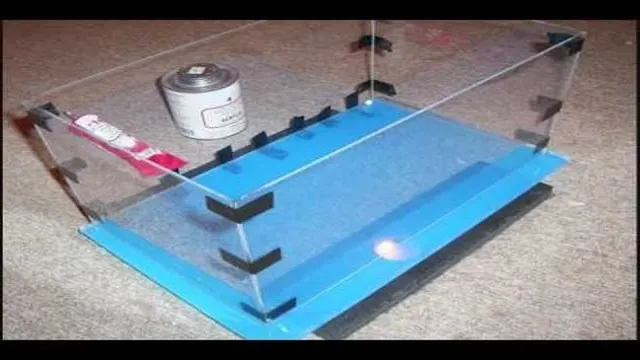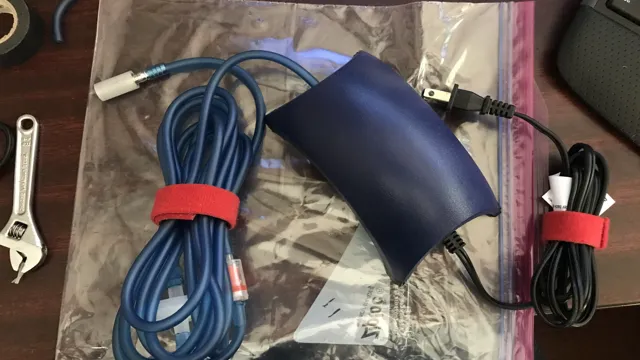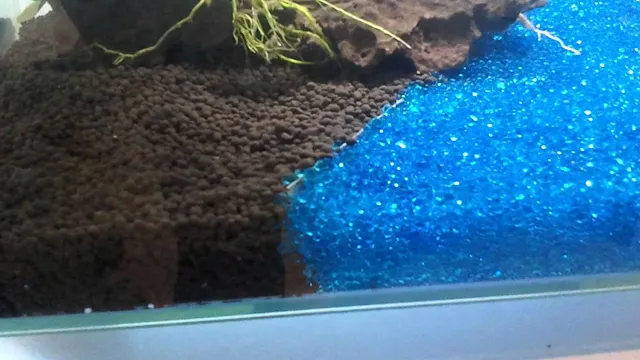Are you looking to add a beautiful aquarium to your home but don’t want to break the bank? Why not try building your very own acrylic aquarium? Not only is it a cost-effective option, but it also allows you to fully customize the size, shape, and style to fit your specific needs and preferences. With a little bit of know-how and some basic tools, constructing your own acrylic aquarium has never been easier. Before you get started, it’s important to do your research and gather all of the necessary materials.
Acrylic sheets, silicone sealant, and tools such as a jigsaw and sander are just a few of the items you’ll need to complete your project. Once you have everything you need, the real fun begins. Building an acrylic aquarium requires patience and attention to detail, but with the right approach, it’s a rewarding experience.
You’ll have the opportunity to create a unique and visually stunning piece for your home while gaining a sense of accomplishment from building something with your own two hands. Whether you’re an established fish enthusiast or simply looking to incorporate a beautiful aquatic display into your home decor, building your own acrylic aquarium is a fun and rewarding project. So why not take the plunge and start building today? With a little bit of effort, you’ll have a stunning aquarium that’s sure to impress all who see it.
Planning and Preparing
If you’re thinking about building your own acrylic aquarium, there are a few things you need to consider before getting started. First, determine the size and shape of your aquarium. Will it fit in the space you have available? Next, decide on the thickness of your acrylic panels.
This will depend on the size of your aquarium and the water pressure it will be under. Acrylic can be more expensive than glass, so keep this in mind when planning your budget. Once you have your materials and tools, you need to prepare the acrylic panels for assembly.
Clean each panel thoroughly and remove any protective film. Use a solvent weld to bond the panels together, making sure to apply even pressure and create strong, secure seams. With some careful planning and preparation, you can build a beautiful and functional acrylic aquarium that will last for years to come.
Selecting the Right Size and Shape
When planning to purchase a rug, it’s important to consider the size and shape that will best fit your space and needs. Start by measuring the area where you want to place the rug and consider the function of the space. If you want to create a cozy seating area in a living room, a larger rectangular rug would be ideal to anchor the furniture and create a defined space.
For a hallway or entryway, a runner rug would be more practical to protect the floors and add style. Consider the shape of the room as well, a round rug can soften the edges of a square or rectangular room and create visual interest. Always keep in mind the purpose of the rug and how it will interact with the rest of the room’s decor.
By selecting the right size and shape, you can elevate your space and achieve both functionality and style.

Gathering Materials and Tools
Planning is essential when it comes to gathering all the necessary materials and tools for a project. One of the first things to consider is the type of project you will be undertaking as this will determine the materials required. It’s important to make a list of all the necessary materials to ensure that nothing is left out and unnecessary trips to the hardware store are avoided.
Checking the stock on hand for items you may have can also help reduce costs. Once the materials required have been identified, the next step is to gather the tools needed. Again, it’s best to make a list of the essential tools and ensure they are available or purchased before commencing the project.
Having everything useful and in reach assists in staying focus and motivated on the project’s completion. Proper planning ensures that everything needed will be readily available, and the project can run smoothly with minimal interruptions.
Building the Frame and Base
When building your own acrylic aquarium, the first step is to create a strong and durable frame and base. This will not only provide support for the aquarium, but also ensure its safety. To begin, determine the size and shape you want your aquarium to be and then cut the acrylic panels accordingly.
Next, use a silicone adhesive to bond the panels together, making sure to create a watertight seal. Once the panels are securely in place, it’s time to construct the frame and base. You can use wood or metal to build the frame, depending on your preference and skills.
The key is to make sure the frame is sturdy enough to hold the weight of the acrylic panels and the water, without bowing or collapsing. For the base, you can use a solid piece of wood or a metal stand, again dependent on your preference. Just remember to make sure that it is level and able to handle the weight of the aquarium.
By following these steps, you can build a strong and reliable frame and base for your acrylic aquarium, ensuring a long and happy life for your aquatic inhabitants.
Cutting Acrylic Sheets
Cutting acrylic sheets can be a bit tricky, but it’s not impossible. Before you start cutting, make sure you have the right tools for the job. A jigsaw with a fine-toothed blade or a circular saw with a blade designed for cutting acrylic are the best choices.
Once you have your tools, it’s time to start measuring and marking your acrylic sheet. You’ll want to use a straight edge and a marker to make your lines as straight as possible. When you’re ready to start cutting, take your time and let the saw do the work.
Don’t force the saw through the acrylic sheet, as this can cause it to crack or break. Remember to wear protective gear, such as goggles and gloves, while cutting. With a steady hand, some patience, and the right tools, you’ll have your acrylic sheet cut to size in no time. (See Also: How to Make a Beautiful Waterfall Inside Aquarium in Easy Steps)
Assembling the Frame and Base
The first step in building a sturdy and reliable bed frame is to assemble the frame and base. To start off, make sure you have all the necessary tools and materials, including screws, bolts, and wooden planks. Begin by laying out the wooden planks for the base and arranging them in a rectangle shape.
Then, drill holes into each plank and screw them together to create a solid base. Next, it’s time to construct the frame. Use the same process of drilling holes and screwing the wooden planks together to create two rectangular frames.
Finally, attach the frames to the base using bolts and ensure they are level and secure. By taking the time to construct a sturdy frame and base, you can have peace of mind knowing that your bed will remain sturdy and reliable throughout its lifespan.
Silicon Sealing
Silicon sealing is a critical step when building an acrylic aquarium at home. It ensures that the aquarium is waterproof and able to hold water without any leaks. The process of silicon sealing involves applying a layer of silicone sealant to the edges of the acrylic panels that will be joined together.
It’s crucial to use a high-quality, aquarium-safe silicone sealant and to ensure that it’s applied evenly and cleanly. Before applying the sealant, ensure that the acrylic panels are clean and dry. Once the sealant is applied, allow it to dry completely before filling the aquarium with water.
It’s important to note that the sealant may take several days to cure fully, so be patient and avoid disturbing the aquarium during this time. Done correctly, silicon sealing can help you build a beautiful and functional acrylic aquarium that will provide a relaxing and calming presence in your home.
Applying Silicon
Silicon sealing is a popular method for sealing gaps and cracks in household items such as bathroom tiles, kitchen counters, and windows. Silicon is a versatile material that is flexible and can withstand temperature changes and exposure to moisture. It is perfect for sealing gaps that need a waterproof barrier.
Applying silicon is straightforward and can be done with or without the aid of a sealing gun. The key to successful silicon sealing is preparation. Ensure that the surface to be sealed is clean and dry, then apply the silicon in a smooth and consistent motion.
After application, use a damp cloth to smooth out the surface and remove any excess silicon. Allow the silicon to dry completely before using the sealed item. With proper preparation and application, silicon sealing can provide a long-lasting and effective barrier against water and moisture.
Allowing Time to Cure
Silicon sealing is an excellent way to ensure your home remains water-resistant and protected from potential damage. However, many homeowners forget the crucial part of allowing enough time for the silicon to cure. Curing is an essential step in the process as it allows time for the seal to harden fully and create an airtight bond.
Not allowing sufficient time for curing can lead to gaps and leaks, leaving your home exposed to the perils of water damage. So, it’s crucial to read the product’s instructions carefully and follow the manufacturer’s recommended curing time before painting or using the area. Remember, taking shortcuts can lead to disappointment and costly repairs, so always give your sealant enough time to cure.
With the right amount of patience, you can ensure a job well done, and your home will remain dry and protected.
Installing Filtration System
If you’re looking to build your own acrylic aquarium, then considering adding a filtration system is a must. Installing a good filtration system is crucial in maintaining the water quality in your aquarium and providing a healthy environment for your aquatic pets. When building your aquarium, you have several options for filtration, including sponge filters, hang-on-back filters, and canister filters.
Each of these has its own advantages and disadvantages, so it’s important to choose the one that best fits your needs. For example, sponge filters are inexpensive and easy to install, but they may not be suitable for larger aquariums. On the other hand, canister filters are more expensive and complex to set up, but they are ideal for larger aquariums and provide better filtration.
Overall, investing in a high-quality filtration system is essential to keep your aquarium water clear and healthy for your fish and aquatic plants.
Selecting Filtration System
If you’re planning to install a filtration system, there are a few things to consider before choosing the right one. Firstly, think about the size of your aquarium and the type of fish you’re keeping. You’ll need a filter that can handle the amount of water in your tank and the bioload of the fish.
Secondly, consider the type of filtration system you want. There are three main types – mechanical, biological, and chemical. Mechanical filters remove debris and waste particles from the water, biological filters use living organisms to break down ammonia and nitrite, and chemical filters use absorbent materials to remove impurities.
Lastly, think about the maintenance required for your chosen filtration system. Some filters may need to be cleaned more often than others, so make sure you can commit to the necessary upkeep. By taking all of these factors into account, you’ll be able to select a filtration system that not only meets your needs but also caters to the health and well-being of your aquatic pets. (See Also: How to Determine How Many Gallons is an Aquarium: A Step-by-Step Guide)
Installing Filtration System into Tank
Installing a filtration system into a tank is an essential step for creating a healthy and thriving aquatic environment. To start, it’s important to select the appropriate filtration system based on the size of your tank and the type of aquatic life you plan on keeping. Once you have your filtration system, it’s time to install it.
Start by carefully reading the manufacturer’s instructions as the setup process may vary slightly based on the specific system you’ve selected. Generally, you’ll need to attach the filter to the back or sides of the tank and set up the intake and outflow tubes. Be sure to fill the filter with the appropriate media, such as activated carbon, sponge, or bio balls.
Finally, plug in the filter and allow it to run for a few hours to ensure it’s working properly before adding any fish or other aquatic life. With a properly installed filtration system, you’ll be well on your way to maintaining a clean and healthy aquatic environment for your pets.
Decorating Your Acrylic Aquarium
When it comes to building your own acrylic aquarium, one of the most exciting parts is decorating it to suit your style and desired aesthetic. One of the first things to consider is the lighting. Lighting can greatly impact the look of your aquarium, so it’s important to choose the right kind and arrange it appropriately.
From there, you can start adding plants, rocks, and other decorations to create a visually appealing underwater world. When choosing plants, be sure they are aquatic and can survive in your water conditions. Rocks should be chosen for their safety to both the fish and the aquarium itself.
And of course, don’t forget to add in some fish or other aquatic creatures to bring your aquarium to life. With a little creativity and planning, you can turn your acrylic aquarium into a stunning centerpiece for your space!
Adding Gravel and Plants
Decorating your acrylic aquarium can be a lot of fun, and adding gravel and plants is a great way to create a beautiful and natural-looking environment for your fish. When choosing gravel, consider the size and color that will complement your aquarium. Don’t forget to wash the gravel thoroughly before adding it to the tank to remove any dust or debris that may have accumulated.
Adding plants is another important step in creating a healthy and visually appealing habitat for your fish. Live plants can offer a variety of benefits, including oxygenation and natural filtration, while also adding color and texture to the tank. Be sure to research the types of plants that are best suited for your aquarium and avoid those that may be harmful to your fish.
With a little creativity and a bit of research, you can create a beautiful and inviting aquarium that both you and your fish will enjoy.
Choosing and Adding Decorations
When it comes to decorating your acrylic aquarium, there are plenty of options to choose from to make your tank feel like a personal oasis. One popular choice is adding plants and foliage to your tank – not only do they look great, but they also provide oxygen and a natural environment for fish and other aquatic life. Another option is adding rocks or driftwood to create hiding places and a more realistic habitat for your fish.
Some aquarium owners even add decorative pieces like statues or ornaments to give their tank a unique and personalized touch. It’s important to remember that when adding decorations, you want to make sure they’re safe for your aquatic life and won’t harm them in any way. With a little creativity and research, you can make your acrylic aquarium a true masterpiece.
Maintaining Your Acrylic Aquarium
If you’re wondering how to build your own acrylic aquarium, it’s important to understand how to maintain it properly as well. First and foremost, you need to clean your tank regularly. Start by wiping down the exterior with a soft, damp cloth and using an aquarium-safe cleaner on the inside.
You should also do partial water changes every two to four weeks to keep the water quality in check. Another key factor is the type of fish and plants you choose to add to your aquarium. Research their specific needs for water temperature, pH, and other conditions to ensure they thrive in their new home.
Finally, be mindful of any scratches or cracks in the acrylic and address them promptly to prevent any leaks or damage. Building an acrylic aquarium can be a rewarding project, just make sure to maintain it properly for the health of your aquatic inhabitants.
Regular Cleaning and Water Changes
Regular Cleaning and Water Changes are crucial for maintaining the health of your acrylic aquarium. Over time, dirt and waste can accumulate in the tank, affecting the water quality and posing a threat to the fish’s health. A regular cleaning routine should include removing any uneaten food, debris, and waste from the tank.
Use a siphon to vacuum the gravel and remove any dirt or algae buildup on the tank’s walls. It’s essential to do water changes regularly as well. Changing 10-15% of the water weekly will help maintain the right water parameters and prevent a buildup of harmful chemicals.
You can use a dechlorinating agent to remove any chlorine from tap water before adding it to the tank. Make sure the water temperature matches the current water temperature in the tank. By keeping your acrylic aquarium clean and doing regular water changes, you can ensure a healthy and happy environment for your fish to thrive in. (See Also: How to Hook Up 3 Wire LED Aquarium Lights: A Comprehensive Guide)
Testing Water Parameters
Maintaining Your Acrylic Aquarium can be a challenging task, but it’s definitely worth it when you get to admire a beautiful underwater world right in your home. One of the most important factors in maintaining your aquarium is testing the water parameters. This means checking the levels of ammonia, nitrite, nitrate, pH, and salinity regularly.
These levels can fluctuate quickly and drastically, leading to stress or illness in fish and other aquatic creatures. Keeping these levels balanced requires dedication, but it’s crucial to ensure the health and longevity of your aquarium inhabitants. Invest in a reliable water testing kit and make sure to test the water weekly.
Don’t be afraid to ask for help or guidance from a professional to ensure your aquarium stays healthy and vibrant for years to come.
Addressing Any Issues
Maintaining an acrylic aquarium requires some effort on your part. Although acrylic aquariums are less prone to breaking than glass aquariums, they can scratch easily, which can make them appear cloudy. To prevent this, you should use a soft cloth to clean the aquarium regularly.
Additionally, you should avoid using abrasive cleaners or sharp objects that can scratch the surface of the aquarium. If you notice any scratches on the aquarium, you should address them right away. For minor scratches, you can use a glass polish or a vinegar and water solution to buff them out.
For deeper scratches, you may need to replace the affected panel. By taking these steps, you can maintain the quality and clarity of your acrylic aquarium for years to come.
Conclusion
In conclusion, building your own acrylic aquarium may seem like a daunting task, but with the right tools and some patience, anyone can do it. With a little bit of creativity and some know-how, you can create a unique and beautiful underwater world for your fishy friends. Just remember to measure twice, cut once, and don’t forget to add a touch of personality to your tank.
Happy building!”
FAQs
What materials do I need to build my own acrylic aquarium?
To build your own acrylic aquarium, you will need acrylic sheets, a solvent cement, a circular saw or jigsaw, a ruler or measuring tape, and silicone sealant.
How thick should the acrylic sheets be for building an aquarium?
The thickness of acrylic sheets required for building an aquarium depends on the size of the aquarium. As a general rule, for every 1 inch of water depth, the acrylic should be at least 1/4 inch thick.
Can I use glass instead of acrylic for my aquarium?
Yes, you can use glass instead of acrylic to build an aquarium. However, acrylic is more durable and resistant to impact than glass, making it a preferred option for larger aquariums.
Do I need any special tools to build my own acrylic aquarium?
You will need some specialized tools such as a circular saw or jigsaw with a fine-toothed blade to cut the acrylic sheets.
What type of cement should I use to glue the acrylic sheets together?
You should use a solvent cement that is specifically designed for bonding acrylic sheets.
Can I build a custom-shaped aquarium with acrylic sheets?
Yes, acrylic sheets can be easily thermoformed into custom shapes using specialized equipment.
How do I prevent leaks in my acrylic aquarium?
To prevent leaks, ensure that the acrylic sheets are glued together with a strong solvent cement and sealed with silicone sealant. Additionally, regularly check the aquarium for any signs of damage or wear and tear.







